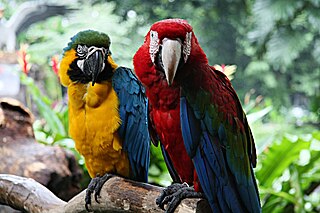 W
WAra is a Neotropical genus of macaws with eight extant species and at least two extinct species. The genus name was coined by French naturalist Bernard Germain de Lacépède in 1799. It gives its name to and is part of the Arini, or tribe of neotropical parrots. The genus name Ara is derived from the Tupi word ará, an onomatopoeia of the sound a macaw makes.
 W
WThe blue-and-yellow macaw, also known as the blue-and-gold macaw, is a large South American parrot with mostly blue top parts and light orange underparts, with gradient hues of green on top of its head. It is a member of the large group of neotropical parrots known as macaws. It inhabits forest, woodland and savannah of tropical South America. They are popular in aviculture because of their striking color, ability to talk, ready availability in the marketplace, and close bonding to humans. They can also live for 65–70 years.
 W
WThe blue-throated macaw, also known as the Caninde macaw or Wagler's macaw, is a macaw endemic to a small area of north-central Bolivia, known as Los Llanos de Moxos. In 2014 this species was designated by law as a natural patrimony of Bolivia, where it is known as barba azul, which means 'blue beard' in Spanish. Until 2010, it was hunted by natives to make feathered "Moxeño" headdresses for "machetero" ritual dances.
 W
WThe Catalina macaw, sometimes known as the rainbow macaw is a first generation hybrid between the blue-and-gold macaw and scarlet macaw. As catalina macaws are hybrids, they do not have a true scientific name. The best way to represent these birds in taxonomy is by the expression Ara ararauna × Ara macao.
 W
WThe chestnut-fronted macaw or severe macaw is one of the largest of the mini-macaws. It reaches a size of around 45 cm (18 in) of which around half is the length of the tail.
 W
WThe Cuban macaw or Cuban red macaw was a species of macaw native to the main island of Cuba and the nearby Isla de la Juventud that became extinct in the late 19th century. Its relationship with other macaws in its genus was long uncertain, but it was thought to have been closely related to the scarlet macaw, which has some similarities in appearance. It may also have been closely related, or identical, to the hypothetical Jamaican red macaw. A 2018 DNA study found that it was the sister species of two red and two green species of extant macaws.
 W
WThe Dominican green-and-yellow macaw, Atwood's macaw or Dominican macaw, is an extinct species of macaw that may have lived on the island of Dominica. It is known only through the writings of British colonial judge Thomas Atwood in his 1791 book, The History of the Island of Dominica:The macaw is of the parrot kind, but larger than the common parrot, and makes a more disagreeable, harsh noise. They are in great plenty, as are also parrots in this island; have both of them a delightful green and yellow plumage, with a scarlet-colored fleshy substance from the ears to the root of the bill, of which color is likewise the chief feathers of their wings and tails. They breed on the tops of the highest trees, where they feed on the berries in great numbers together; and are easily discovered by their loud chattering noise, which at a distance resembles human voices. The macaws cannot be taught to articulate words; but the parrots of this country may, by taking pains with them when caught young. The flesh of both is eat, but being very very fat, it wastes in roasting, and eats dry and insipid; for which reason, they are chiefly used to make soup of, which is accounted very nutritive.
 W
WThe great green macaw, also known as Buffon's macaw or the great military macaw, is a Central and South American parrot found in Nicaragua, Honduras, Costa Rica, Panama, Colombia and Ecuador. Two allopatric subspecies are recognized; the nominate subspecies, Ara ambiguus ssp. ambiguus, occurs from Honduras to Colombia, while Ara ambiguus ssp. guayaquilensis appears to be endemic to remnants of dry forests on the southern Pacific coast of Ecuador. The nominate subspecies lives in the canopy of wet tropical forests and in Costa Rica is usually associated with the almendro tree, Dipteryx oleifera.
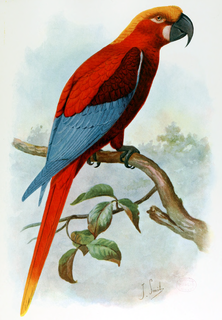 W
WThe Jamaican red macaw is a hypothetical species of parrot in the family Psittacidae that lived on Jamaica.
 W
WThe Martinique macaw or orange-bellied macaw is a hypothetical extinct species of macaw which may have been endemic to the Lesser Antillean island of Martinique, in the eastern Caribbean Sea. It was scientifically named by Walter Rothschild in 1905, based on a 1630s description of "blue and orange-yellow" macaws by Jacques Bouton. No other evidence of its existence is known, but it may have been identified in contemporary artwork. Some writers have suggested that the birds observed were actually blue-and-yellow macaws. The "red-tailed blue-and-yellow macaw", another species named by Rothschild in 1907 based on a 1658 account, is thought to be identical to the Martinique macaw, if either has ever existed.
 W
WThe military macaw is a large parrot and a medium-sized macaw that gets its name from its predominantly green plumage resembling a military parade uniform. It is native to forests of Mexico and South America and though considered vulnerable in the wild, it is still commonly found in the pet trade industry.
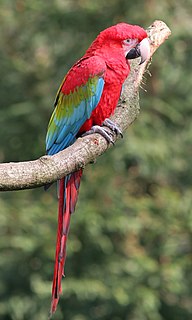 W
WThe red-and-green macaw, also known as the green-winged macaw, is a large, mostly-red macaw of the genus Ara.
 W
WThe red-fronted macaw is a parrot endemic to a small semi-desert mountainous area of Bolivia. It is a critically endangered species; it has been successfully bred in captivity, and is available, if not common, as a pet. It is also sometimes known in the literature as Lafresnaye's macaw, named for the French ornithologist Frédéric de Lafresnaye, who was one of the first to describe the species.
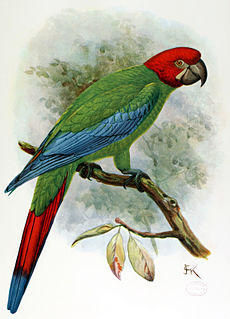 W
WThe red-headed macaw or Jamaican green-and-yellow macaw may have been a species of parrot in the family Psittacidae that lived in Jamaica, but its existence is hypothetical.
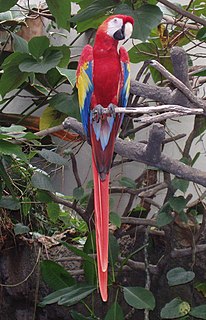 W
WThe scarlet macaw is a large red, yellow, and blue Central and South American parrot, a member of a large group of Neotropical parrots called macaws. It is native to humid evergreen forests of the Neotropics. Its range extends from south-eastern Mexico to Peru, Ecuador, Colombia, Bolivia, Venezuela and Brazil in lowlands of 500 m (1,600 ft) up to 1,000 m (3,300 ft), the Caribbean island of Trinidad, as well as the Pacific island of Coiba. Formerly, it ranged north to southern Tamaulipas. In some areas, it has suffered local extinction because of habitat destruction, or capture for the parrot trade, but in other areas, it remains fairly common. It is the national bird of Honduras. Like its relative the blue-and-yellow macaw, scarlet macaws are popular birds in aviculture as a result of their striking plumage.
 W
WThe St. Croix macaw or Puerto Rican macaw, is an extinct species of macaw whose remains have been found on the Caribbean islands of St. Croix and Puerto Rico. It was described in 1937 based on a tibiotarsus leg bone unearthed from a kitchen midden at a pre-Columbian site on St. Croix. A second specimen consisting of various bones from a similar site on Puerto Rico was described in 2008, while a coracoid from Montserrat may belong to this or another extinct species of macaw. The St. Croix macaw is one of 13 extinct macaw species that have been proposed to have lived on the Caribbean islands. Macaws were frequently transported long distances by humans in prehistoric and historical times, so it is impossible to know whether species known only from bones or accounts were native or imported.